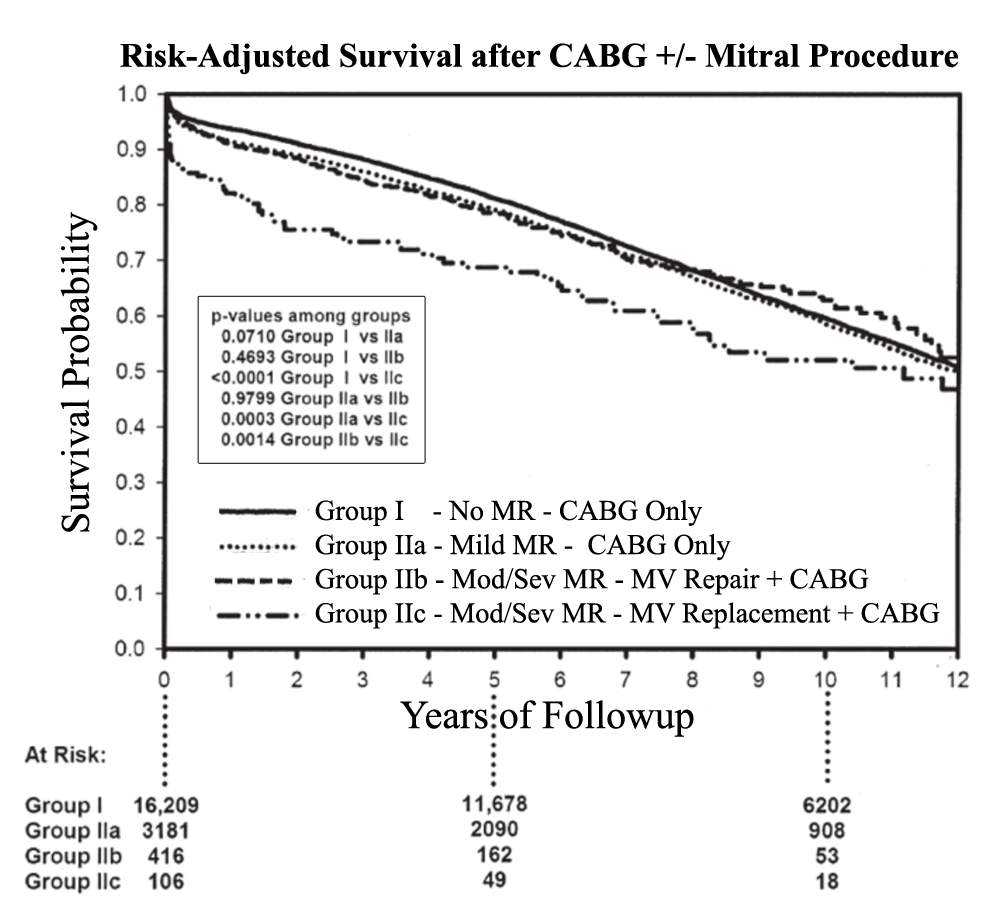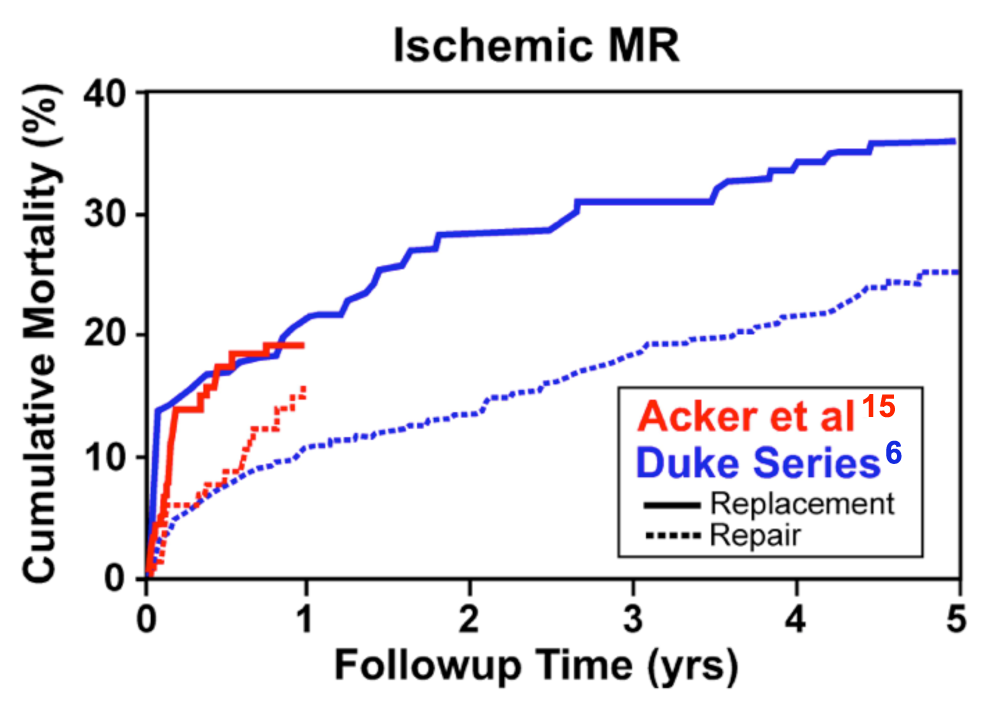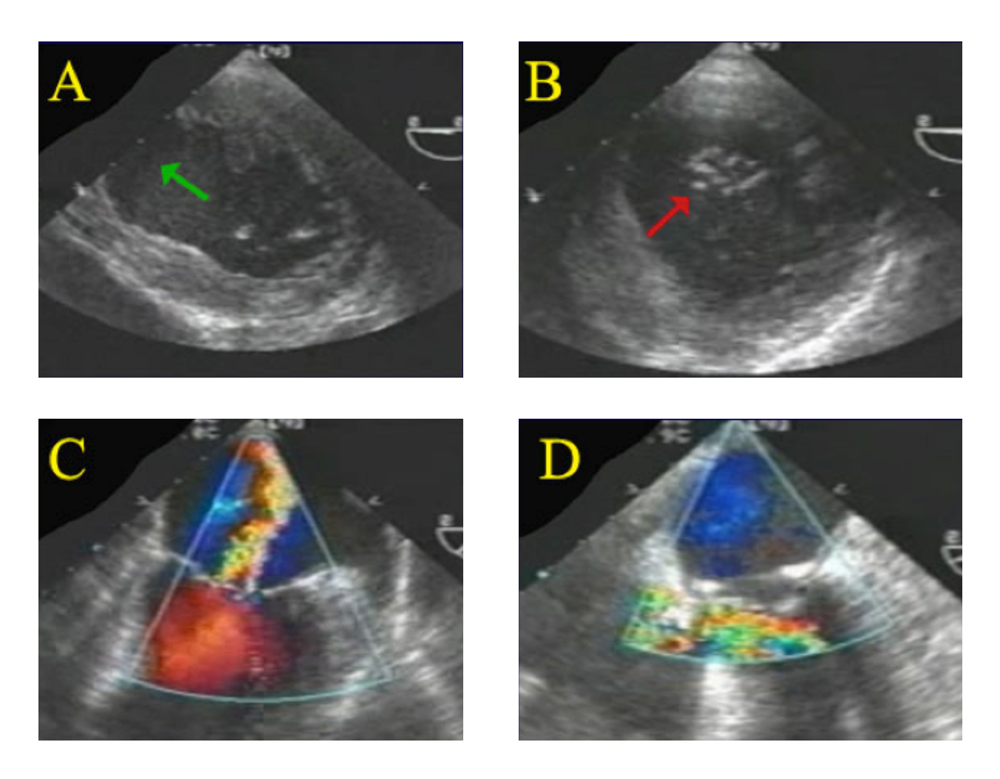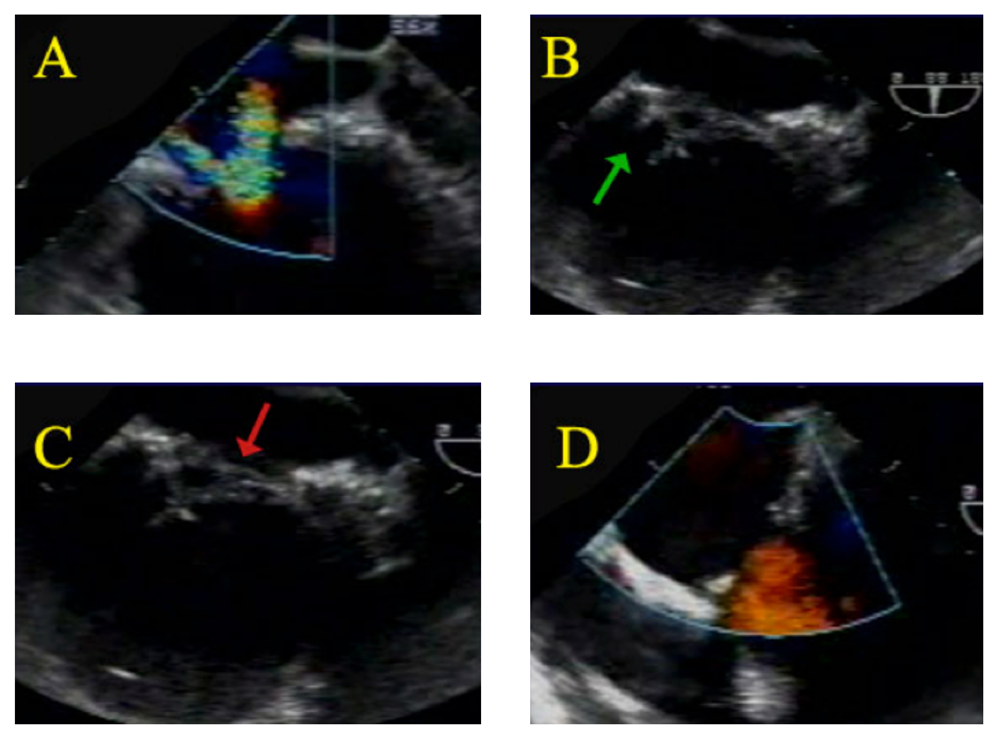Mitral Valve Repair vs. Replacement for Ischemic MR: An Ongoing Debate
Introduction
Mitral regurgitation (MR) precipitated by myocardial infarction (MI) was thoroughly described in 1968 by Dr. George Burch using the term papillary muscle dysfunction syndrome,1 now commonly termed ischemic mitral regurgitation. Before modern echocardiography, Burch defined all the salient features, including clinical and pathophysiologic characteristics (Figure 1). Ischemic MR usually follows a posterior wall MI involving the right and/or circumflex coronary arteries, with limited revascularization reversibility. The infarct can influence valve performance in a number of ways: posterior annular dilatation, leaflet tethering due to infarct expansion, and papillary muscle elongation (or rupture). Early experience with prosthetic valve replacement was suboptimal, and Kay and others reported better results with commissural annuloplasty,2 eventually evolving into formal mitral valve repair.3 Many subsequent studies suggested that effective mitral repair achieved better results than valve replacement (Figure 2), and repair became a primary therapy.4 However, with the recent publication of the Cardiothoracic Surgical Trials Network (CTSN) trial "Comparing the Effectiveness of Repairing Versus Replacing the Heart's Mitral Valve in People With Severe Chronic Ischemic Mitral Regurgitation,"5 the issue of superiority versus equivalence of ischemic MR repair and replacement has again gained prominence. This article provides a critical review of this topic.
Figure 1
Figure 2
CTSN Randomized Clinical Trial
The CTSN trial5 involved 125 randomized cases of patients with ischemic MR who were undergoing mitral valve repair and 126 cases of patients with ischemic MR who were having replacement. Longitudinal outcome comparisons then were performed between the two surgical cohorts. Although this study has provided a substantial contribution to the field by making us rethink our approach to ischemic MR, questions remain. We clearly understand that in some patients, mitral replacement may be preferred based on longitudinal freedom from MR recurrence. However, in some patients, mitral repair has excellent safety and durability. So let us take a closer look at this landmark study. Less than 10% of the over 3,000 patients screened actually formed the 251 patient cohort. The study was underpowered to assess survival differences, but after stating such, the authors performed a survival analysis that showed no survival difference at 1 year.5 The authors concluded that "our findings contradict much of the published literature on this topic" and "there was no significant between-group difference in clinical outcomes." Of great concern is the 32% post-repair MR recurrence over the first postoperative year, which is clearly unacceptable. Interestingly, early cumulative mortalities in the CTSN trial are superimposable on other independent data (Figure 3), but CTSN repair deaths later increased because the repairs failed.
Figure 3
Very little information was given about repair methods utilized in the participating 22 CTSN centers. Were repair techniques among the 22 programs coordinated through education and case proctoring? Were techniques for leaflet tethering and papillary elongation applied liberally? Little can be learned from this trial if inadequate repairs were performed, but repair types were not documented. Failure to correct tethering or prolapse6 or geometrically ineffective annuloplasty could account for the differences illustrated in Figure 3. Despite the excellent contributions of the CTSN, a randomized study design cannot compensate for potential flaws in trial structure or other important methodologic challenges.
Mitral Valve Repair Versus Replacement
The first statistical analysis of mitral repair versus replacement for ischemic MR was published from Duke University in 1988, and the data suggested significant survival benefits with valve repair.7 As repair was adopted, overall mortality decreased,8 and a follow-up risk-adjusted observational study 20 years later4 confirmed significant survival advantages associated with repair (Figure 2) along with single-digit repair-failure rates. One strength of the 30-year Duke experience was application of consistent rigid geometric ring annuloplasty, with leaflet procedures selected as needed. Although the subject has been argued back and forth over the ensuing decades, The Society of Thoracic Surgeons database studies have shown that mitral valve repair has become a primary approach to mitral valve surgery in the United States9 and that this trend is continuing.10 Consistent with other studies, the early mortality for repair in the CTSN trial approximated 7% (versus 14% for replacement) (Figure 3). In fact, the absolute operative survival benefit of ischemic MR repair may be greater than for any other valve disease etiology, and conversion to repair over time is almost certainly a major factor associated with improving mitral procedural outcomes.9,10 Thus, a mortality cost seems to be associated with mitral valve replacement (Figures 2-3), whereas repair failure is likely a surgically controllable phenomenon.
As early as the 1990s, Duran and associates, using non-geometric downsized flexible rings, observed a 30% early repair-failure rate and attributed much of the failure to persistent leaflet tethering.11 Stanford University investigators found that selective geometric reduction in the anterior-posterior annular diameter was important,12 and they also suggested the utility of generous posterior leaflet patching for tethered leaflets using autologous pericardium.13 In fact, specific commercially produced geometric rings were developed for this purpose and proved useful for improved annular remodeling.14 Many other methods for management of leaflet tethering were devised,15-17 and techniques for ischemic MR repair continued to progress.
Repair Techniques
Most cases of ischemic MR involve posterior annular dilatation (Figures 4-5), and a simple geometric annuloplasty ring is sufficient for repair.18,19 Associated fetal commissural cusps and clefts should be closed.7 Occasionally, the posterior wall expands dramatically with the infarct, and the posterior papillary muscle tethers a leaflet, preventing coaptation. Adjunctive maneuvers such as anterior or posterior leaflet augmentation, papillary muscle sling, or papillary relocation are commonly cited.20 The technique of inserting an autologous pericardial patch into the posterior leaflet13,21 provides a large margin of safety in case ventricular geometry continues to change postoperatively.22,23 Rarely, papillary muscles can elongate or partially tear, producing leaflet prolapse and requiring Gore-Tex (W.L. Gore & Associates, Inc., Flagstaff, AZ) artificial chordal replacement (taking care to connect neo-chords to an un-infarcted papillary muscle).24 Using these techniques, mitral valve repair for ischemic MR is associated with excellent early and late results, with a recurrence/reoperation rate of less than 10% and improved outcomes.25-28 Thus, effective reconstructive techniques should be specifically tailored to the pathologic anatomy if the full benefits of ischemic MR repair are to be achieved.29
Figure 4
Figure 5
Conclusion
In summary, many studies suggest that mitral valve repair for post-infarction ischemic MR is associated with a substantial survival benefit. Clearly, the contrary result of the CTSN trial has reactivated interest in mitral replacement. This is a durable solution but with a mortality cost in many reports. In our view, repair should not be abandoned because excellent results are achievable in patients with appropriate patho-anatomic techniques. Full geometric annuloplasty rings that selectively reduce the anterior-posterior annular diameter, along with methods that address leaflet tethering, are very important. In recent experience, a reparative approach has been largely adopted by US surgeons and may have contributed to falling mortality rates for mitral valve surgery. This topic no doubt will continue to be debated, and ongoing clinical investigation will be necessary to refine evolving concepts.
References
- Burch GE, DePasquale N, Phillips JH. The syndrome of papillary muscle dysfunction. Am Heart J 1968;75:399-415.
- Kay GL, Kay JH, Zubiate P, Yokoyama T, Mendez M. Mitral valve repair for mitral valve regurgitation secondary to coronary artery disease. Circulation 1986;74:188-95.
- Carpentier A, Didier L, Deloche A, et al. Surgical anatomy and management of ischemic mitral valve incompetence. Circulation 1987;76(1 Suppl):I-776-84.
- Milano CA, Daneshmand MA, Rankin JS, et al. Survival prognosis and surgical management of ischemic mitral regurgitation. Ann Thorac Surg 2008;86:735-44.
- Acker MA, Parides MK, Perrault LP, et al. Mitral-valve repair versus replacement for severe ischemic mitral regurgitation. N Engl J Med 2014;370:23-32.
- Kron IL, Hung J, Overbey JR, et al. Predicting recurrent mitral regurgitation after mitral valve repair for severe ischemic mitral regurgitation. J Thorac Cardiovasc Surg 2015;149:752-61.
- Rankin JS, Feneley MP, Hickey MS, et al. A clinical comparison of mitral valve repair versus valve replacement in ischemic mitral regurgitation. J Thorac Cardiovasc Surg 1988;95:165-77.
- Rankin JS, Livesey SA, Smith LR, et al. Trends in the surgical treatment of ischemic mitral regurgitation: effects of mitral valve repair on hospital mortality. Semin Thorac Cardiovasc Surg 1989;1:149-63.
- Gammie JS, Sheng S, Griffith BP, et al. Trends in mitral valve surgery in the United States: results from the Society of Thoracic Surgeons Adult Cardiac Surgery Database. Ann Thorac Surg 2009;87:1431-9.
- Badhwar V, Rankin JS, He X, et al. The Society of Thoracic Surgeons Mitral Repair/Replacement Composite Score: A Report of The Society of Thoracic Surgeons Quality Measurement Task Force. Ann Thorac Surg 2016;101:2265-71.
- Tahta SA, Oury JH, Maxwell JM, Hiro SP, Duran CM. Outcome after mitral valve repair for functional ischemic mitral regurgitation. J Heart Valve Dis 2002;11:11-8.
- Tibayan FA, Rodriguez F, Langer F, et al. Annular remodeling in chronic ischemic mitral regurgitation: ring selection implications. Ann Thorac Surg 2003;76:1549-55.
- Langer F, Rodriguez F, Cheng A, et al. Posterior mitral leaflet extension: an adjunctive repair option for ischemic mitral regurgitation? J Thorac Cardiovasc Surg 2006;131:868-77.
- Daimon M, Fukuda S, Adams DH, et al. Mitral valve repair with Carpentier-McCarthy-Adams IMR ETlogix annuloplasty ring for ischemic mitral regurgitation: early echocardiographic results from a multi-center study. Circulation 2006;114(1 Suppl):I-588-93.
- Hvass U, Tapia M, Baron F, Pouzet B, Shafy A. Papillary muscle sling: a new functional approach to mitral repair in patients with ischemic left ventricular dysfunction and functional mitral regurgitation. Ann Thorac Surg 2003;75:809-11.
- Langer F, Schäfers HJ. RING plus STRING: papillary muscle repositioning as an adjunctive repair technique for ischemic mitral regurgitation. J Thorac Cardiovasc Surg 2007;133:247–9.
- Peeler BB, Kron IL. Suture Relocation of the Posterior Papillary Muscle in Ischemic Mitral Regurgitation. Oper Tech Thorac Cardiovasc Surg 2005;10:113-22.
- Mihos CG, Santana O. Annuloplasty Ring Selection in Ischemic Mitral Regurgitation for Valve Repair During Coronary Artery Bypass Grafting. J Card Surg 2015;30;906.
- Mohebali J, Chen FY. Mitral valve repair for ischemic mitral regurgitation. Ann Cardiothorac Surg 2015;4:284-90.
- Mihos CG, Pineda AM, Santana O. Targeting the Papillary Muscles in Mitral Valve Repair for Ischemic Mitral Regurgitation. Rev Cardiovasc Med 2015;16:182-8.
- Jassar AS, Minakawa M, Shuto T, et al. Posterior leaflet augmentation in ischemic mitral regurgitation increases leaflet coaptation and mobility. Ann Thorac Surg 2012;94:1438-45.
- Rankin JS, Daneshmand MA, Milano CA, Gaca JG, Glower DD, Smith PK. Mitral valve repair for ischemic mitral regurgitation: review of current techniques. Heart Lung Vessel 2013;5:246-51.
- Rankin JS. Mitral Valve Repair for Complex Ischemic Mitral Regurgitation. AATS Mitral Conclave 2013: http://www.jsrmd.com/ftp/57_ACIMR.m4v.
- Rankin JS, Alfery DD, Orozco RE, Binford RS, Burrichter CA, Brunsting LA III. Techniques of Artificial Chordal Replacement for Mitral Valve Repair: Use in Multiple Pathologic Disorders. Oper Tech Thorac Cardiovasc Surg 2008;13:74-82.
- Glower DD, Tuttle R, Shaw LK, Orozco RE, Rankin JS. Patient survival characteristics after routine mitral valve repair for ischemic mitral regurgitation. J Thorac Cardiovasc Surg 2005;129:860-8.
- Williams ML, Daneshmand MA, Jollis JG, et al. Mitral gradients and frequency of recurrence of mitral regurgitation after ring annuloplasty for ischemic mitral regurgitation. Ann Thorac Surg 2009;88:1197-201.
- Virk SA, Sriravindrarajan A, Dunn D, et al. A meta-analysis of mitral valve repair versus replacement for ischemic mitral regurgitation. Ann Cardiothorac Surg 2015;4:400-10.
- Deja MA, Grayburn PA, Sun B, et al. Influence of mitral regurgitation repair on survival in the surgical treatment for ischemic heart failure trial. Circulation 2012;125:2639-48.
- Drake DH, Zimmerman KG, Hepner AM, Nichols CD. Echo-guided mitral repair. Circ Cardiovasc Imaging 2014;7:132-41.
Keywords: Aortic Valve, Coronary Artery Bypass, Coronary Vessels, Echocardiography, Transesophageal, Heart Ventricles, Infarction, Mitral Valve, Mitral Valve Insufficiency, Myocardial Infarction, Papillary Muscles, Pericardium, Prolapse, Risk Adjustment, Systole
< Back to Listings





